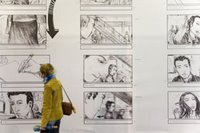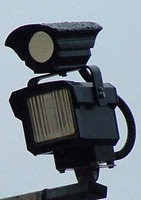I Need My Space ...Without a doubt, the French are a nation of film fans. On TV chat shows, across countless magazines, you name it and ‘celebrity’ is splashed across the lot. Last weekend, the French capital hosted the first ‘Cinema Show’, giving the public a behind the scenes look at everything to do with the big screen.
The sprawling Porte de Versailles exhibition centre, in the south of Paris' 15th arrondissement, has played host to many a trade show, business convention and political rally. During the city riots of the early 60's, it's sister building, Le Palais des Sports, was used as a detention centre.
Nice. Last weekend, however, the mood was 'entertainment only' as the doors of hall 6 opened for a first-timer - Le Salon du Cinema.

Jonathan Bryant, one of the show's organisers told me that
"the show gives the general public a chance to look behind-the-scenes of movie-making. Everything from cameras to audio dubbing, make-up and special effects to editing and stunt performing". Indeed, the public
did arrive - and in their thousands. At one point, on the Saturday afternoon, they had to shut the doors, such was the demand for tickets. As I waited at the cloakroom to leave my jacket, I could only feel sorry for those in the huge lines before the cash tills. My press card gives me a continued source of free entry to anything I care to visit.
From the sheer size of the crowds and how difficult it was to negotiate the show's narrow avenues, I couldn't help but think this was going to turn out to be another
'dog and pony show'. After my first tour around the booths and exhibition areas, I was beginning to think that I ought to turn tail and head for the nearest café. There were too many displays, too many stands, not enough space, nowhere to breathe and tunnel vision had begun it's forward march, so I headed back to the wide open spaces of the press area.

Rather than wander aimlessly around the show, I sipped a tepid coffee and scrutinised the press pack. Who's here, who's doing what, when and where. As I was writing a piece for British consumers, I donned my detective hat and looked for logical connections and links to the exhibitors on the floor. Fat lines of yellow dayglow marker sliced through items that interested me. Before the show opened, the organisers had e-mailed a data sheet to the pre-regisitered members of the press, listing all and sundry in the smallest print they could possibly find. I had scanned it, glasses perched on the end of my generous nose, but got terribly lost in it's complex layout.

One thing stood out, however, which I had already pinned down. On the Sunday afternoon, a public Q&A session had been confirmed with a certain French hero of mine. I had found one of those 'British links' and a thick yellow line went through the programme. Rémy Julienne is not a name I would expect anyone to immediately register, but anyone who knows his/her stuff would. As it happens, I do. In 1969 a British film was released that was to change the radiator grill of car chases forever, the benchmark which would dictate vehicle stunts from that date onwards. In '68, the American's came out with
"Bullitt" (directed by a Brit) and it's famous San Francisco hill chase, but a year later we had
"The Italian Job". Julienne devised and, with his team, had performed the sequence in and around Milan, Italy.
"Such was the complexity of the sequences" he told me,
"Paramount had to double the duration of my contract - which was a bonus!"
Now a veteran of six James Bond films, the sprightly 76 year-old and been joined in the family business by his sons, Dominque (pictured) and Michel. Although semi-retired, he still has fond memories of the good old days. Julienne admits that filming
"The Italian Job" wasn't always easy.
"The British production team were far too pragmatic", he explained with a grin,
"the assistant director and I were not the best of friends". One particular obstacle, which led to a heated dispute, was how to get the Mini's up a ramp and into the getaway coach.
"To begin with", says Julienne,
"the engineers insisted that it would be better if they put the Minis on a rolling conveyor belt which was being pulled behind the coach. I insisted that their idea wouldn't work and that the Minis could be driven straight in, from off the road". Many years before, Julienne had tried this with a low-loader back in his native France and knew that it would work.
"Eventually I convinced them. They took the conveyor belt away and with the production team crammed into the drivers compartment, the coach was driven at 80kph and I drove it the Mini in myself at 120kph! After that, a bond of trust was forged between us". If Julienne says he can do something, he'll work it out and come up with the goods. He is currently working on building a stunt school in the French countryside where the next generation of dangermen will study under the grand master. I was delighted to receive an invitation to visit ...
Other professionals who work in French film almost fell over themselves to appear at the show. Jonathan Bryant went on to explain that
"the response has been remarkable, we even had people ringing us to ask if they could participate. There are people out there who are really keen, they want to meet the public and talk about their art".

Another dayglow stripe ripped it's way through my programme when I stumbled across Wallace & Gromit producers, Peter Lord and David Sproxton. They'd flown in to give a 90 minute forum, answering a barrage of questions from animation students keen to learn from their heroes. As the session drew to a close the stage was mobbed as Messers Lord and Sproxton were gently led away to the Aardman booth - where the mobbing continued.

The one thing that struck me, as I watched the duo patiently listen to their visitors, is that if you make a rather handsome living from playing with plasticine, then you retain certain childlike qualities. Peter Lord (on the left) was only too enthusiastic to chat to me about the new workflow that the Aardman Studio has adopted;
"We're using everything from High Def video to pro stills cameras", he said. pointing the chunky black box slung over my shoulder.
"With all this new technology we've kept everything in-house. We've managed to speed up the entire process, from initial filming to post production is now all under one roof - a good working production line". Tired and perspiring after their grilling from the public, Lord and Sproxton remained forever smiling. Despite a heavy schedule, the pair happily popped into an adjoining booth to watch an animation made by students of a Paris film school. The men from the West Country were obviously impressed.

Bollywood also did it's best to be noticed. The French distributor,
'Bollywood Zone', arrived with a catalogue of Asia's finest sing-along dance numbers, all 'ready to watch' with added French subtitles. Although lacking the viewership of, say, the UK, they we keen to emphasise that the French were already buying and enjoying Bollywood classics. However, bringing a quartet of dusky maidens along would have certainly been key to a successful sale - or two.

As the public milled around the booths and exhibits, some found their way into a purpose-built studio where a short film was being made by Nils Tavernier (son of Bertrand). Tavernier Jnr and his team of actors and technicians were busy making a 'short' during the run of the show. As we all know, film-making is not exactly the speediest of processes and the public, from behind a control barrier, were often left in total bewilderment as to what was going to happen next. No-one ever took the time to explain to the masses what was involved and what exactly going on. Very much a case of
'them and us' - we get on with what we're doing and they stand and gawp.

Those interested in how animals are trained for the big screen could form and orderly queue to pet a python, eyeball an eagle or oggle an owl. A wildlife studio had brought along a veritable menagerie, though 90% of it's exhibits were motorised dummy lions, polar bears and alligators. I spoke with the 'head-keeper' who was ecstatic to have found a Brit to chat to;
"Oh, we've worked at BBC Bristol many times - but they have such a small studio at their wildlife HQ!" Obviously, he hasn't tried living in a Paris apartment.

How about a broken nose then? I should add that this wasn't an option I gave the animal man but something that was going on in another booth. Some of the industry's best make-up artists were happily administering gore and gashes to those members of the public who fancied going home on public transport. As I wasn't in the mood to surprise my beloved by returning home with a fresh compound fracture, I headed out into the winter sunshine and fresh air.
All in all, it wasn't a bad show. The organisers realise that it was cramped but seem happy that it had been a success. The salon looks as though it has built a future for itself and judging by the mass of humainty that crammed itself through the doors, it'll be some years before someone finally shouts
"it's a wrap!"Stu
 Got To Get A Message To You: David Beckham is going to play footy in the US - a deal worth 193m Euros. I wonder, is this for him to play ball or to stop her from re-launching her singing career? You choose.
Got To Get A Message To You: David Beckham is going to play footy in the US - a deal worth 193m Euros. I wonder, is this for him to play ball or to stop her from re-launching her singing career? You choose.
































